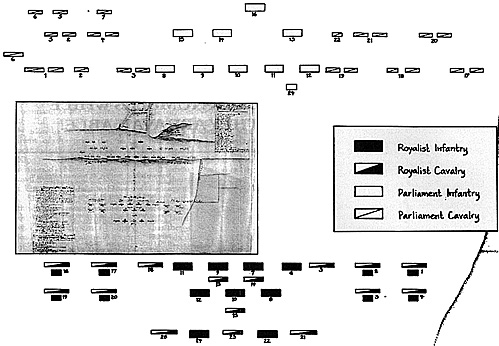Royalist Army
Description of his Majestie's Armee as they were drawn unto severall bodyes at the Battle of Naseby (on) the 24th day of June 1645 (actually the 14th June, of course) consisting of 4000 foot and 5500 horse with 12 pieces of Ordonance which Battle was fought the same day.
The Armee command by his Highnesse Prince Rupert General and that day charged in the Right Wing of the Armee with Prince Maurice of 5 Divisions of Horse and 200 Musquetiers:
(1) Prince Rupert's and Prince Maurice's Troops.
(2) Prince Rupert's Regiment.
(3) The Queen's and Prince Maurice's Regiments.
(4) The Earle of Northampton's Regiment.
(5) Sir William Vaughan's Regiment.
Sir Bernard Astley's Tersia of Foot:
(6) The Duke of York's Regiment.
(7) Colonel (Sir Edward) Hopton's Regiments.
(8) Colonel (Sir Richard) Page's Regiment.
Sir Henry Bard's Tersia of Foot:
(9) Sir Henry Bard's and Colonel (Rhys) Thomas' Regiment.
(10) Sir John Owen's and Colonel (Radcliffe) Gerard's Regiments.
Sir George Lisle's Tersia:
(11) Sir George Lisle's and (Colonel William) St. George's Regiments
(12) Shrewsbury Foot commanded by (Lieutenant) Colonel (George) Smith.
(13) (14) (15) Three Divisions of Horse between the Foot commanded by Colonel (Sir Thomas)
Howard.
The left wing of Horse commanded by Sir Marmaduke Langdale, being the Northern Horse (in) five Divisions of 200 Masquetiers:
(16) (17) (18) Three Divisions of Northern Horse.
(19) Colonel (Sir Horatio) Cary's Regiment.
(20) Northern Division of Horse.
(21) (22) Two Divisions of Horse.
(22) His Majesties Regiment of Foot.
(23) His Majesties Life Guard of Horse with his own person.
(24) Prince Rupert's Regiment of Foot.
Note: The infantry blocks shown behind the cavalry on each wing consist of musketeers, Fifty men in each block.
Parliamentarian Army
Description of the Parliament Armee as they were drawne unto severall bodyes at the Battle of Naseby (on) the 24tb (14th) June 1645 commanded by Sir Thomas Fairfax.
(1) General's Division of the Life Guards.
(2) Sir Robert Pye's Regiment.
(3) Colonel (Edward) Whalley's Regiment.
(4) Colonel (Thomas) Sheffields Division.
(5) Colonel (John) Fiennes' Regiment.
(6) Colonel (Edward) Rossiter's Regiment.
(7) The Associated Horse.
(8) The General's Regiment of Foot.
(9) Colonel (Edward) Montagu's Regiment.
(10) Colonel (John) Pickering's Regiment.
(11) Sir Hardress Waller's Regiment.
(12) Major General (Philip) Skippon's Regiment.
(13) Lieutenant Colonel Pride's Regiment.
(14) Colonel (Robert) Hammond's Regiment.
(15) Colonel (Thomas) Rainsborough's Regiment.
(16) (Lieutenant) Colonel Pride's Reserve.
(17) Colonel (John) Butler's Regiment.
(18) Colonel (Cornelius) Vermtryclen's Regiment.
(19) Commissary General (Henry) Ireton's Regiment.
(20) Colonel (Nathaniel) Rich's Regiment.
(21) Colonel (Charles) Fleetwood's Regiment.
(22) The Troops ofthe Association.
(23) Train of Artillery Guarded with Firelocks (not shown on the redrawn plan).
(24) The Forlorn Hope of Commanded Musketeers.
Note: de Gomme records that the line of hedges shown on the right of his plan were lined by 'Dragons of the parlement', Colonel John Okey's Regiment of Dragoons.
Sir Bernhard De Gomme's plan of the Battle of Naseby (14 June 1645). The main illustration is a copy of the plan by Dereck Stone, with the original shown as a photograph. De Gomme was an engineer officer on the staff of the Royalist General Prince Rupert, and his duties included drawing up plans of his general's proposed battle formations for distribution amongst the senior commanders. This type of plan was drawn up at the commencement of the campaign and adjusted when major changes in the army's composition occurred, such as the addition or subtraction of significant contingents. The surviving plan in the British Library is a more carefully drawn version of the original 'Headquarters' plan; and also includes the Parliament's army formation, probably from the design shown in Joshua Sprigge's book on the New Model Army campaigns Anglia Rediviva (printed in 1647).
It is a valuable plan for anyone with an interest in the Battle of Nasby, for three reasons. Firstly, it shows the development of Prince Roberts tactical ideas; he had evidently decided upon this style in 1644 after the Battle of Marston Moor (2 July 1644), since the same type same type of tactical plan showing the Royalist army at the relief of Donnington Castle (10 November 1644).
Secondly, it allows a comparison between the tactical styles of the two armies, Royalist and Parliamentarian, at their decisive meeting. The Royalist plan shows Prince Rupert's preference for a German style of deployment developed during the Thrity Years War.
The Parliament battle plan drawn up by Philip Skippon and Oliver Cromwell shows their preferance for the simpler style of the Dutch army.
Thirdly, the space actually taken up by the formations of each side can be calculated since the plan shows a contemporary professional soldier's view of how the formations were drawn up. This shows the amount of space which would be required between each unit. The amount of space taken up by the units themselves can be calculated by estimating their strengths and how many lines deep they were drawn up six deep for infantry and three deep for cavalry for both sides in 1645 (original by courtesy of the board of Trustees of the British Library and Redrawn by Derek Stone)

Back to English Civil War Times No. 54 Table of Contents
Back to English Civil War Times List of Issues
Back to Master Magazine List
© Copyright 1998 by Partizan Press
This article appears in MagWeb (Magazine Web) on the Internet World Wide Web.
Other military history articles and gaming articles are available at http://www.magweb.com